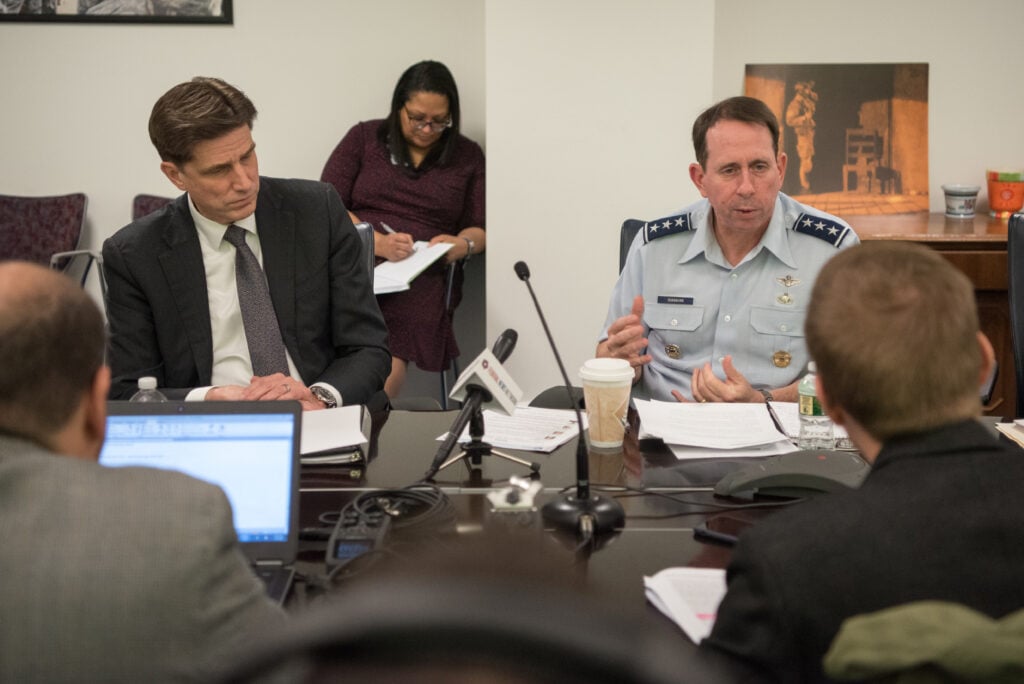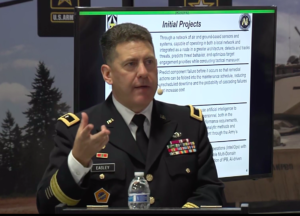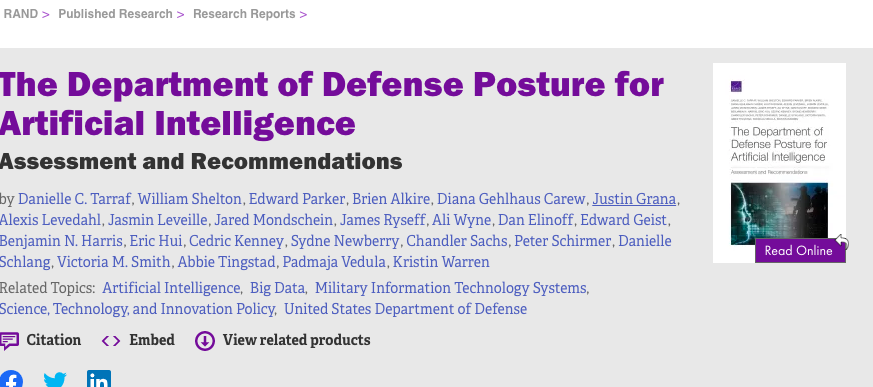By SYDNEY J. FREEDBERG JR.
 WASHINGTON: A congressionally mandated study warns the Defense Department’s current efforts to harness artificial intelligence are “significantly challenged” by shortfalls in organization, planning, data, and talent, and testing, setting the stage for changes in the next defense policy and spending bills.
WASHINGTON: A congressionally mandated study warns the Defense Department’s current efforts to harness artificial intelligence are “significantly challenged” by shortfalls in organization, planning, data, and talent, and testing, setting the stage for changes in the next defense policy and spending bills.
The problems RAND identified include a major mismatch between the sweeping responsibilities assigned to the year-old Joint Artificial Intelligence Center and its authority to achieve them, “making it exceedingly difficult for the JAIC to succeed.” To solve the problem, the RAND report’s central recommendation is to strengthen the JAIC — a recommendation Congress is now certain to at least consider next year as it drafts the 2021 defense bill.
A word of caution. It’s the Joint AI Center director, Lt. Gen. Jack Shanahan, who hired RAND to do the report in the first place. (Congress required him to submit a report, but it didn’t dictate who should write it). While RAND is highly respected for its independent, in-depth scholarship, it’s not known for challenging the fundamental premises of the questions the Defense Department asks.
How much AI spending is there for JAIC to coordinate, anyway? That’s actually a tricky question. The long-delayed 2020 appropriations bill last night includes unspecified “significant investments [in] artificial intelligence,” but we’ve not seen a specific figure. Any number would be an estimate anyway. AI spending is scattered across the Defense Department under a host of different terms and is often buried in larger projects.
The RAND report includes an annex digging through the 2020 budget, but it’s not available to the public. The only figure the public version gives for AI-specific activity is $15 million – 0.002 percent of the DoD budget. But that doesn’t include any AI work done as part of a larger program, such as a weapons system, cloud computing contract, or business software. “DoD budgets do not account for AI when it is a small part of a larger platform,” RAND says, “making it hard to track overall spending.”
Strengthening the Joint AI Center
“There is evidence to support that DoD has taken the right approach in establishing the JAIC as a centralized focal point for DoD’s AI strategy,” says the RAND study, released this morning, “[but] DoD failed to provide the JAIC with visibility, authorities, and resource commitments, making it exceedingly difficult for the JAIC to succeed in its assigned mandate.”
Now, the RAND report doesn’t include one recent reform that postdates its drafting. In October, Deputy Defense Secretary David Norquist officially designated the JAIC director as “senior official with primary responsibilities for the coordination of activities related to the development and demonstration of AI and machine learning,” working in tandem with R&D undersecretary Mike Griffin’s technical director for AI research and development. It’s far from clear what this new role actually involves, but JAIC and the R&D shop are supposed to provide an implementation plan by April 2nd.
Even this doesn’t give JAIC any authority to control AI spending across the military. The AI center can only provide “guidance” to the services, not direction.
One option RAND recommends to shore up the Joint AI Center, part of the Office of the Secretary of Defense, is to give JAIC new legal authorities over budgeting and personnel in the four armed services. But the report admits this would require Congress to pass legislation increasing the power of OSD over the services’ acquisition programs, reversing the Hill’s recent efforts to decentralize authority back to the service chiefs.
Brig. Gen. Matthew Easley, director of the Army’s Artificial Intelligence Task Force
 RAND’s alternative plan, cut down to fit within the limits of the current law, would strengthen the existing AI efforts in each of the services – of which the Army’s AI Task Force is the most developed – and bring their chiefs together on a DoD-wide council, chaired –but not controlled — by the JAIC director.
RAND’s alternative plan, cut down to fit within the limits of the current law, would strengthen the existing AI efforts in each of the services – of which the Army’s AI Task Force is the most developed – and bring their chiefs together on a DoD-wide council, chaired –but not controlled — by the JAIC director.
The 2020 defense spending bill gives the Air Force $3.0 billion for the B-21 bomber program and $960 million for Next Generation Air Dominance in RDT&E money.
In either case, RAND recommends JAIC and the services replace their current vague aspirations with clear five-year plans, complete with unambiguous measures of success or failure to judge them against. It also urges Defense Department leadership and the JAIC itself to figure out what the AI Center’s mission really is and make that clear to a confused workforce.
In 102 interviews conducted between April and August – 59 officials from DoD, nine from other federal agencies, 25 from industry, and nine academics – “we noted a lack of clarity among our interviewees on the JAIC’s mandate, roles, and activities[,] how it fits within the broader DoD ecosystem and how it connects to the services and their efforts,” RAND said. “It points to a lack of clarity about the raison d’être of the JAIC … The confusion might not be entirely on the part of the audience. DoD needs to have a clearer view of what it wants the JAIC to be.”
Major Recommendations
The RAND report’s recommendations go well beyond reorganization. In particular, the report raises major concerns about how the Defense Department handles its data, its human capital, and its test programs to assure AI actually works as advertised. Some key excerpts (emphasis ours) – and yes, RAND is pedantic enough to consistently use “data” as a plural:
DoD faces multiple challenges in data, including the lack of data. When data do exist, impediments to their use include lack of traceability, understandability, access, and interoperability of data collected by different systems…. DoD leadership is often presented with inconsistent values originating from different systems for the same data point, undermining leadership’s willingness to trust data from DoD systems or make decisions based on data at all… Pursuing enterprise AI at scale is realistic in the near term but would require fundamentally transforming DoD’s culture into a data-enabled one that values data and uses them to their full potential—a monumental endeavor.
The current state of AI VVT&E [verification, validation, testing, and evaluation] is nowhere close to ensuring the performance and safety of AI applications, particularly where safety-critical systems are concerned…. [S]ustained, accompanying investments in infrastructure and enablers and VVT&E are needed to ensure success….. All funded AI efforts should include a budget for AI VVT&E, including any critically needed testing infrastructure.
DoD lacks clear mechanisms for growing, tracking, and cultivating AI talent, even as it faces a very tight AI job market…. On the positive side, the services are actively leveraging their hiring flexibilities, both for civilians and the officer corps…. Interviews across DoD cited intense competition with the private sector, the limited ability to compete on salary, and long hiring processes.
Ultimately, the RAND report believes that the Defense Department can make major advances in AI, but it has to be “realistic” about how long that will take. Business-style “enterprise” applications – like finance, personnel, and data management – will be feasible much sooner than “operational” AI capable of handling the chaos and ambiguity of actual combat. “As a rule of thumb,” RAND says, “investments made starting today can be expected to yield at-scale deployment in the near term for enterprise AI, in the middle term for most mission-support AI, and in the long term for most operational AI.”
Shanahan’s boss, Pentagon Chief Information Officer Dana Deasy, welcomed RAND’s report as a “thorough and thoughtful critique” to be considered along with recent recommendations from the Defense Innovation Board and the National Security Commission on AI.


No comments:
Post a Comment